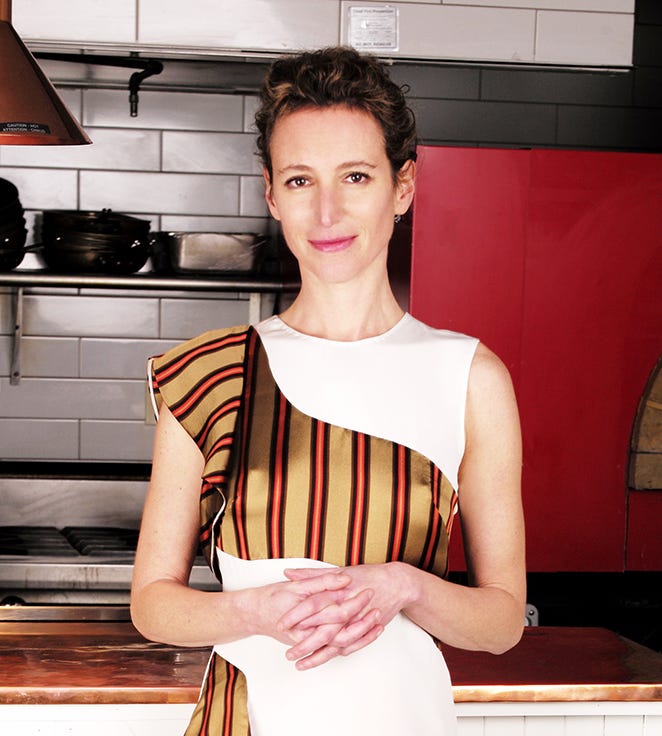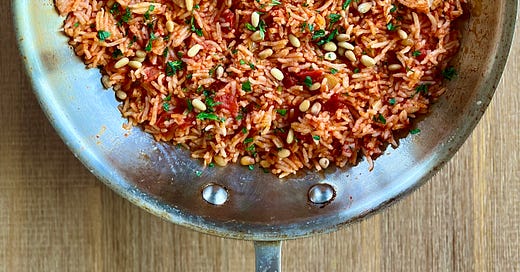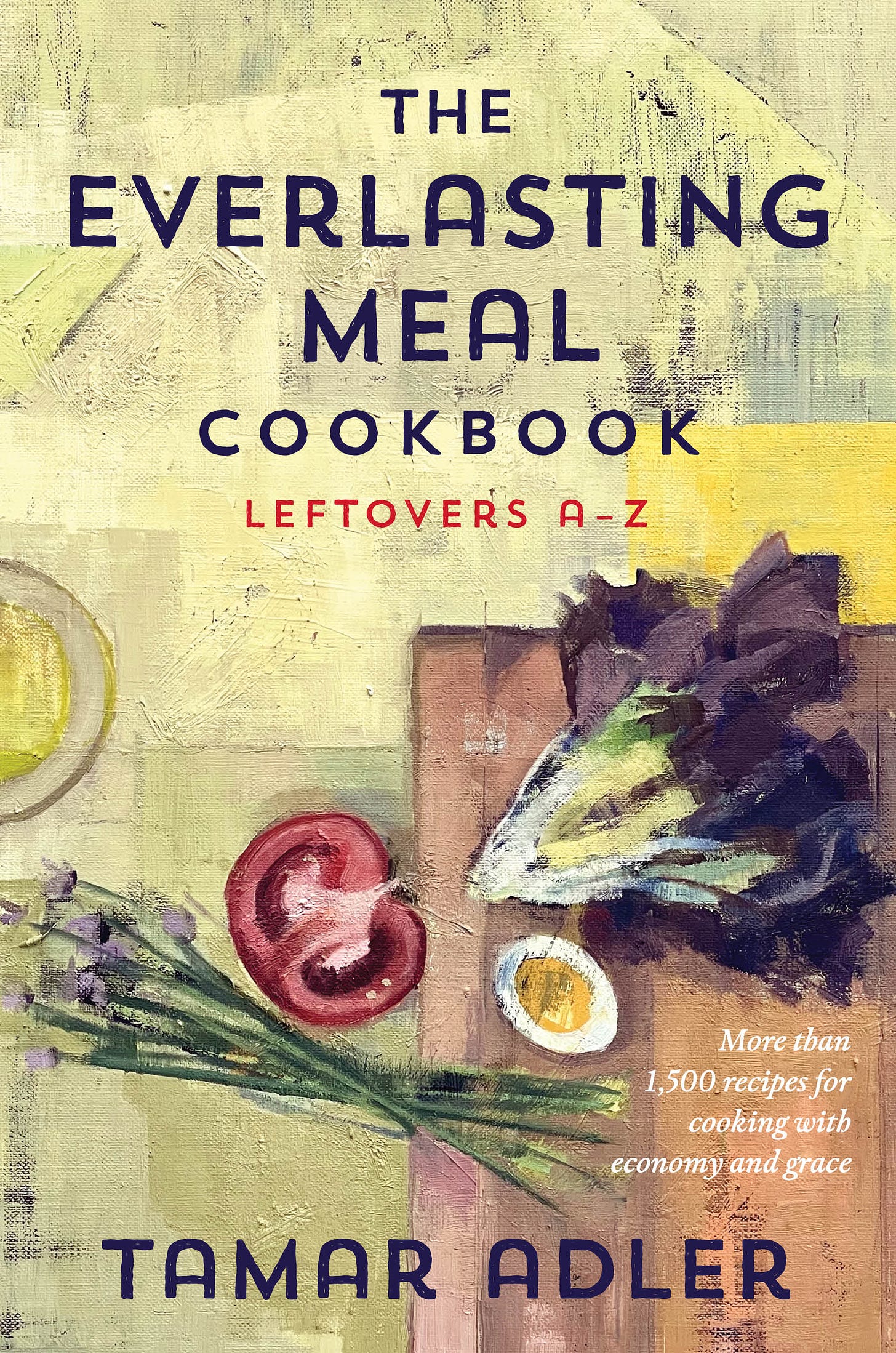

Discover more from The Jewish Table
Sephardi Tomato Rice (Arroz con Tomat)
Plus: The Four Questions with Tamar Adler of The Everlasting Meal Cookbook
Sometimes the simplest dishes are the most memorable, don’t you think? From Persian jeweled rice and Bukharian beef and carrot plov, to Ashkenazi rice kugel, global Jewish cuisine has no shortage of festive rice dishes. But one of my favorites, and the one I make most frequently, is Sephardi Tomato Rice (Arroz con Tomat).
Don’t let the short list of ingredients fool you. A simple blend of aromatics and tomato elevates plain white rice into a dish that simultaneously stands out at the table while playing well with just about any main you set next to it.
According to Olive Trees and Honey by Gil Marks, tomato rice “developed among Sephardim living in the Ottoman Empire following the arrival of the tomato in the sixteenth century.” It is particularly beloved within Jewish communities hailing from Turkey and Rhodes. Yellow rice, made with precious saffron, was typically served for Shabbat and other special occasions, while red rice became more of a weekday dish.
Today, tomato rice remains a staple amongst Sephardi families. (A similar Sephardi dish, called fideos tostados, or “toasted noodles” softens small pieces of browned vermicelli in broth and tomato sauce.) There are many variations, some with onion and others without, and using either tomato sauce, tomato paste, diced tomatoes, or a combination of each. Some cooks call it pink rice, rather than red. I’ve even seen contemporary American versions where ketchup stands in for tomato sauce. Honestly? That sounds delicious.
The Sephardi Tomato Rice dish I’m sharing here is a little different. Instead of using dried rice grains, I started with two cups of already cooked, leftover rice. (See my interview with Tamar Adler below for the inspiration.)
My son Max’s favorite meal is pan-fried chicken breasts, roasted broccoli, and rice, which means we regularly have leftover cooked rice to use up. So while I love more traditional recipes for Sephardi Tomato Rice (and included one in The Jewish Cookbook), it is hard to argue with a dish that transforms stale cooked rice into something truly delicious.
To be clear: this recipe is not intended to be served on Shabbat. It only calls for 2 cups of cooked rice (which is usually about what we have leftover), so it is not enough to serve guests. But on a weeknight, when you open the fridge and find that life has given you leftovers, it is quick and deeply satisfying. You might just find yourself purposely making more rice than you think you can eat in one sitting in anticipation of its leftover potential!
Sephardi Tomato Rice (Arroz con Tomat)
Serves 2-4
3 tablespoons olive oil
1/2 small yellow onion, finely chopped
1 garlic clove, finely chopped
1/2 teaspoon kosher salt, plus more to taste
1/4 teaspoon sugar (optional)
2 cups (260 g) leftover cooked white rice (I used basmati, but any long grain rice works)
2/3 cup (160 ml) tomato purée (passata) or diced tomatoes
1 tablespoon water
Heat the oil in a medium frying pan set over medium-low heat. Add the onion and cook, stirring occasionally, until softened and lightly browned, 5 to 7 minutes. Stir in the garlic, salt, and sugar, if using, and cook until fragrant, about 1 minute.
Add the cooked rice and sauté, stirring often, until lightly toasted, 2 to 3 minutes. Stir in the tomato purée and water, cover the pan, and cook until the rice is plumped and warmed through, about 5 minutes. Remove from the heat and let stand, still covered, for another 5 minutes. Taste and add more salt, if needed. Serve hot or warm.
Sephardi Tomato Rice (Arroz con Tomat) is delicious as-it, but also fun to dress up. Here are a few ideas:
Mix in 1 tablespoon finely chopped fresh basil, parsley, or dill right before serving
Stir in about 1/2 teaspoon of grated lemon zest along with the garlic
Garnish with toasted pine nuts or almonds, or fried onions (homemade or these)
Top with grated parmesan or another hard, salty cheese

The Four Questions Interview: Tamar Adler
Welcome to the latest installment of The Four Questions, The Jewish Table’s semi-regular interview segment featuring Jewish food luminaries. This week I’m excited to be joined by Tamar Adler—a former chef (at Prune and Chez Panisse, among other places), James Beard award-winning author, and bona fide leftover queen.
I first became smitten with Adler’s work after she published An Everlasting Meal in 2012—a practical and eminently readable treatise on cooking and eating. I loved how the book embraced making mistakes in the kitchen, defined triumphant cooking as an exercise in frugality rather than ego, and suggested that leftovers were the beginning, not an end of the story.
Her new book The Everlasting Meal Cookbook: Leftovers A-Z (Scribner), which was published last month, is the perfect follow up to the original. Organized like a reference book of leftover ingredients (though with a significantly more engaging and lyrical presentation than a typical reference book), Adler shares ideas for repurposing any and every leftover ingredient you might find in your fridge. Asparagus bottoms, citrus peels, and carrot tops? The last dollops of yogurt or peanut butter in a jar? That to-go container of mozzarella sticks from last night’s dinner out, or a half full box of stale donuts? The Everlasting Meal Cookbook covers them all.
As a long time, devoted composter (I usually either haul food scraps to our weekly farmer’s market or drop them into the Lomi), I sometimes get a little complacent about repurposing food. But while turning mushroom stems and onion peels into soil is undoubtedly a good thing, turning them into mushroom stock to make a future pot of miso can be even more rewarding!
Adler took some time to speak with me about dishes that lend themselves particularly well to “cleaning out the fridge,” the technique her father used to teach kids about food waste at Jewish summer camp, the potential benefits of using Chat GPT while writing a reference book, and the surprising way she recently repurposed boiled baby carrots on television.
You can follow Tamar on Instagram here. And read previous The Four Questions interviews with Smitten Kitchen’s Deb Perelman, Ori Zohar from Burlap and Barrel, and many others, here.
Mainstream American food culture tends to skew anti-leftover, and has conditioned home cooks to throw away food if it has the slightest speck of mold. How do you help people get over any ingrained “ick factor” they might have learned?"
I don’t think I am super attuned to that ambivalence, which is good. I can write passionately about using all of something, or finding ways to use a food past its prime. That’s my super power—to be able to write about cooking with leftovers as practical, delicious, and necessary. But my editor was very helpful with pointing out places where maybe I needed to coax or coach people a little more. To let them know things like it’s okay to assess a piece of cheese, cut off the part that makes you feel queasy, and carry on with the rest.
For people who are just beginning their journey with this approach to home cooking, what types of dishes offer a good place to start?
One is the frittata-ization of anything! In The Everlasting Meal Cookbook, I have a basic frittata recipe where you can take whatever you have to use up, mix it with beaten eggs, pour it into a hot pan, and stick it into the oven for 12 minutes. It is transformational.
I also eat some version of fried rice all the time. We serve a lot of rice at dinner, which means there’s always cold, hard rice in the fridge. But that makes the best fried rice. To make great fried rice, there are a few techniques that matter. You need a large and hot enough pan with enough fat to make sure the grains fry. Then anything you add should be added from driest to wettest so you optimize for fry-ability. If you have a little sauce to pour in, do it at the very end. Following those basic instructions, you can put almost anything into fried rice and have it turn out great. It is very empowering.
How did you go about coming up with entries to include in the book, and how did you organize it?
Well I was completely unrealistic at first—I wanted to put in everything. I hired a woman named Amanda Kingsley, who is a florist and forager, to help me make ingredient spreadsheets for every letter of the alphabet. The idea was to identify every food you could possibly have as a leftover. And then I fine-tuned the list a bit—but having two brains working on it together definitely made the list more comprehensive. If Chat GPT existed then, we could’ve asked it. I wouldn’t want to write a fellowship application with it, but its list-making capabilities would have been very helpful!
After I settled on a final list, I cooked through it and tried to put in all the recipes in an A-Z way. But a friend who read through the manuscript commented that it made for some infelicitous pairings, like apple peels next to anchovy oil. So I ended up grouping the ingredients by category instead to make the search more pleasurable. So now, if you are looking up what to do with oil from an anchovy tin, the entry is surrounded by other fishy things.
What surprised you most while working on this book?
I was delighted to find something I could do with my son’s sandwich crusts! I made a variation of upma, which is a South Indian dish. A lot of the kid-focused stuff felt very useful and relevant. I did a demo on The Drew Barrymore Show with leftover boiled baby carrots. Once they are boiled and your kid has eaten one of them, they can be hard to transform into a different context. But we made an “any vegetable mash,” where you combine a bunch of boiled baby carrots with cream, and its super delicious.
BONUS QUESTION: Has your Jewish heritage informed your approach to cooking in any meaningful way?
Growing up my family was quite observant. One of the reasons I am so focused on time at the table is because I spent so much time at the table when I was a kid. I couldn’t go out on Friday night or Saturday, so we always had friends over and entertained.
There also was a sense of tikkun olam [the Jewish concept of “repairing” or improving the world] in my upbringing. My father was ahead of his time as an anti-waste advocate. He ran a Jewish summer camp, and had all of the food waste bags from the dining hall brought to our Shabbat service to let the campers see how much we threw away. So that sense of environmental stewardship and not taking things for granted was tied to our Judaism.
SAVOR: A Sephardic Food and Music Experience
On the subject of Sephardi cuisine, I was honored to recently play a small part in an incredible project, which combines Sephardi music and recipes.
Spearheaded by Sarah Aroeste, a musician specializing in Ladino (the Jewish-Spanish dialect) music, and food writer Susan Barocas, Savor invited chefs and food writers to create recipes inspired by traditional Ladino songs about food. (Turns out there are many.) As the only fully Ashkenazi contributor to the project—I shared the pan de calabaza/Sephardi pumpkin bread from The Jewish Cookbook—I feel a little bit like an interloper. But mostly I felt honored to be included.
Here’s a tiny taste of the project. All the chef bios/music/recipes can be accessed at savorexperience.com















I fell hard for The Everlasting Table and consult it all the time. And if I needed any prodding to get the new book, you’ve provided it!